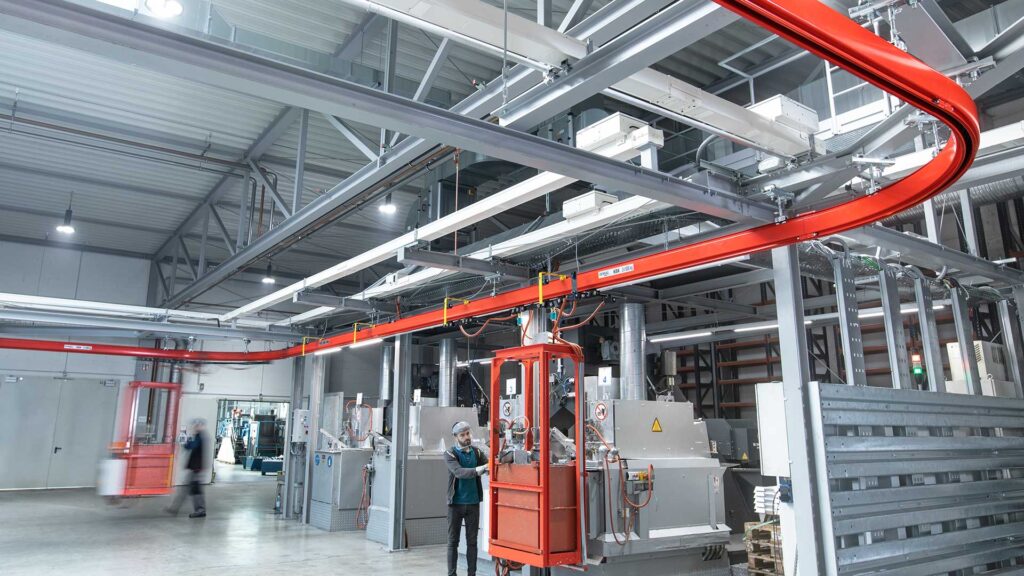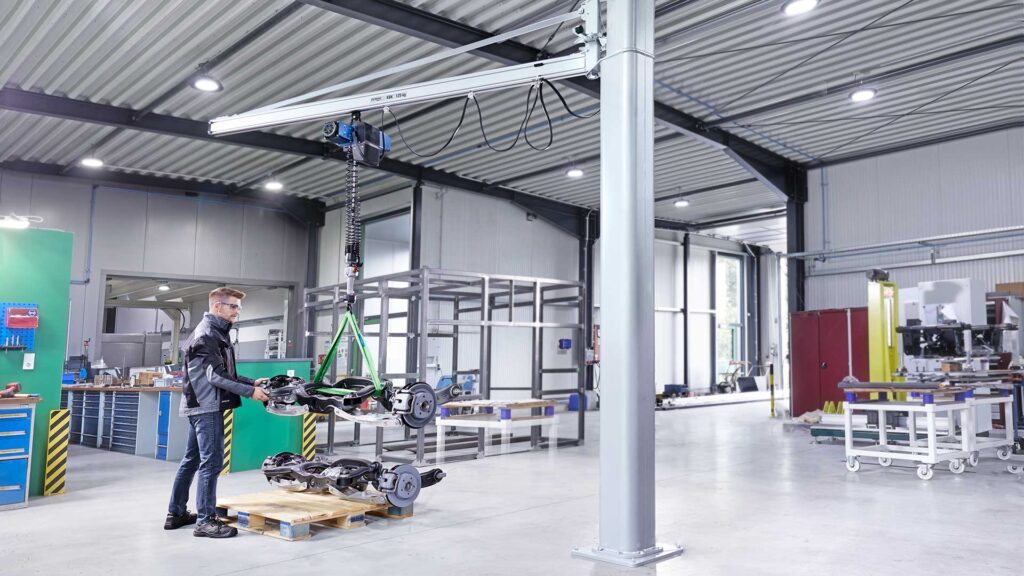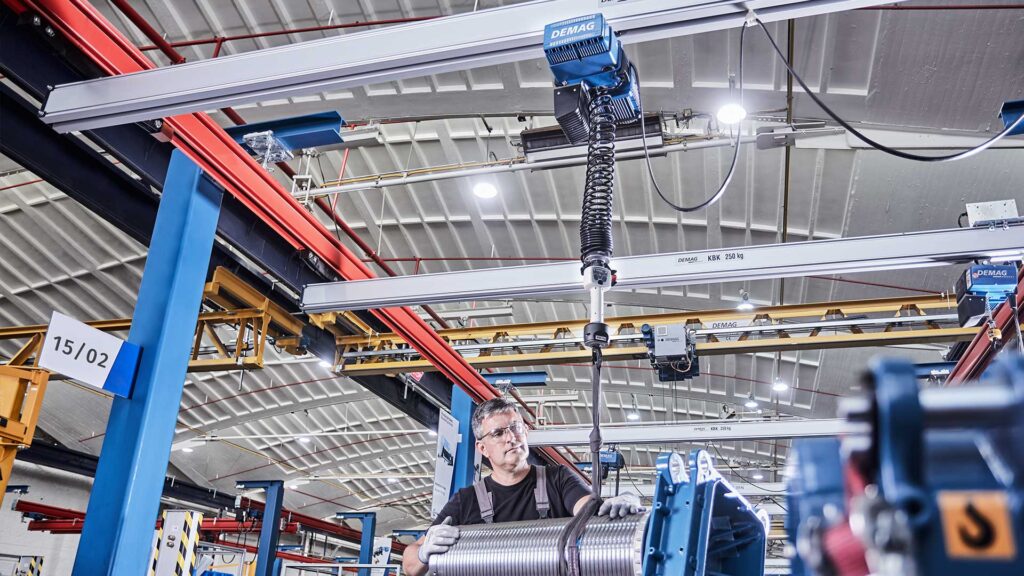Starting the RFQ process and choosing an enclosed rail crane system can be daunting, but it doesn’t have to be. Whether you’re purchasing a brand-new system or replacing or revamping an existing one, there are some details to prepare you to work with your crane manufacturer and dealer. Read through our guide as you navigate the RFQ process.

Gather Information for Discussion with Your Demag Dealer
You know your business best so gathering some basic information in preparation to working with your Dealer will assist the process. If you are replacing or enhancing an existing enclosed rail system, like a KBK modular crane system, you may have many of these answers at your fingertips. A new system will potentially have more unknown information your Dealer can help you with but have as much information as possible up front.
Looking for industry standards is an important part of your research for the discussion with your Dealer. Not only do these standards keep your workforce safe, but it creates a foundation for safer products. The Monorail Manufacturers Association (MMA), an industry group of the Material Handling Institute (MHI), has the MMA Certified program. This program allows workstation crane & monorail manufacturers to become Certified by meeting specific product safety and design requirements.
1) Identify the Processes to Accomplish with an Enclosed Rail System
As you start your purchase journey for an enclosed rail crane, jib crane, or freestanding workstation crane, the first step is understanding your processes. You know what lifting and material handling needs to happen in the manufacturing processes within your facility. There may be special ways you want to move a component or new ways you want to grip the component as it moves to enhance your assembly processes. There is no one better than you and your workforce knowing the positives and negatives of the processes you currently perform.
Along with this, you’ll be considering critical inputs like capacity and location of the system within your facility. These factors may dictate the crane configuration required and location of the solution. A properly sized and configured solution optimizes your lifting and handling processes while optimizing workforce safety. Don’t forget, manufacturers who are MMA Certified must meet specific product design and safety standards to further promote.
2) Crane Configurations to Meet Your Requirements

There are many solutions that may meet your requirements when it comes to material handling and lifting. Ceiling mounted enclosed rail crane systems attach to the superstructure of your building. They allow for lifting, positioning, and movement within an X, Y, Z axis. These systems can be routed through your facility to optimize your assembly and manufacturing processes. If you consider a ceiling mounted system, always check the structural details of your building.

Monorail Systems allow for lifting and transportation of loads directly beneath the monorail. These systems can be equipped with a lifting device or tooling on a trolley to enhance the flow of components through your factory. Monorail systems can be routed around corners and be enhanced with different accessories like turn tables, track switches, and automation for efficient material flow throughout your facility.

Freestanding workstation cranes allow you to add a material handling and lifting area with an X, Y, Z axis nearly anywhere within your existing floor space. The crane is supported with a support system of columns attached to the concrete floor of the building. Workstation cranes can create optimized assembly and manufacturing areas, retool an underused area of your production facility, and add lifting and material handling capabilities to buildings without robust superstructures.

Jib cranes are found in nearly every industry. These cranes can be wall mounted or pillar mounted, allowing for lifting within an area up to 360 degrees. The jib arm reaches out from the wall or pillar mount, allowing for lifting and handling in a circular shaped area. These cranes can fit nearly anywhere within a facility to build a new cell for manufacturing in unused space or replacing manual lifting in an existing area of the facility.

3) Comparing the Benefits of Aluminum or Steel Runway and Bridges
From Demag, our enclosed rail is available in both steel and aluminum. Each type of rail brings benefits to your application. Generally speaking, aluminum rail is more ergonomic for manual push applications. Steel rail can support heavier loads on bridges and runways. Both types of track can be used in a KBK crane to meet the specific requirements of your lifting. Read more about choosing steel and aluminum rail.
Budget is an important detail when adding a crane or monorail system to your operations. There are ways to optimize your budget with enclosed rail cranes and monorail systems. Using standard track lengths is more economical than a customized length. This means the final system designed may be slightly shorter or longer than originally planned. When you work with your authorized Demag dealer to create your solution, they can help you navigate standardized rail lengths to optimize your budget.
4) Measuring Dimensions for Lifting and Handling

A critical measurement to understand is height- height under the beam, floor to trolley saddle height, and lift height for the hoist. These measurements assure your system gives you the proper amount of space to work within the area and lift and move materials.
Height under the beam for your enclosed rail crane or monorail assures that lifting and moving process can be accomplished between the bridge and floor on a ceiling mounted system. Floor to trolley saddle height assures the same on a freestanding workstation crane, giving you the support beam height necessary. Lift height is a critical measurement, measuring the distance from the floor to the saddle of the lifting device hook when the hook would be in the uppermost position.
5) Electrical Requirements & Powering Your System
Every geographic area has a specific electrical requirement. In the USA and Canada, we typically handle 3-phase power, 480V or 575V with 60Hz. Regardless of your location, assuring your crane system can work with the local electrical requirements is critical.
In addition to the geographic electrical requirements, there are different ways to deliver reliable power within the crane or monorail system. Demag KBK track can be equipped with an integrated conductor line, potentially eliminating the need for festooning. Festooning is a flexible option for electrical and compressed air powered applications.
6) The Lifting Device & Travel
Choosing a lifting device and trolley is just as important as the crane or monorail configuration. Demag lifting devices are designed to seamlessly integrate into a KBK crane or monorail system with the right trolley solution to meet your requirements. DC chain hoists allow you to lift loads traditionally with a pendant or with the Manulift handle with one hand on the control handle above the hook and the other hand on the load.
Balancers are found in assembly and manufacturing operations for intelligent lifting with a float mode. Available as electric or pneumatic balancers, both allow an operator to float the load and maneuver it into place with 2 hands on the load. Demag offers the DCBS Electric Balancer. This balancer is based off our DC chain hoist product line, so it is a chain balancer with modes to meet your requirements. It’s easily customized to your exacting needs. The D-BP II Air Balancer is available as an up/down balancer or it can be customized to meet your exact requirements with end tooling when clean air power is preferred.
In addition to lifting a load, moving a load on the crane or monorail system is accomplished with a trolley. Trolleys can be manual push or electric. Many factors can dictate whether you are required to use one or the other, for instance weight of the load or the travel path. Manual push trolleys are appropriate for certain applications and need to be ergonomic to keep your workforce safe. Electric trolleys have a travel drive attached that moves the load. The operator controls the trolley and lifting device with one pendant or radio. Less commonly, trolleys can be powered with clean air, pneumatic power.
Choosing the Demag KBK Crane or Monorail Solution to Meet Your Requirements

Demag KBK modular crane and monorail systems are an industry standard! Trusted in OEM automotive manufacturing facilities and production lines for complex handling, Demag KBK crane and monorail systems are flexible, customizable and safe for your workforce and work processes. Even in simple crane applications, KBK delivers a reliable, efficient, and safe solution for your workforce and your operations.
The Modular and Flexible Crane or Monorail Solution
Demag KBK Systems are designed for the ultimate in flexibility, meeting your exacting requirements. From simple cranes lifting loads up to 2 Tons to complex material flow systems, KBK delivers a reliable solution for any industry. KBK makes load handling precise and ergonomic, making work safer and more efficient. Adding a Demag lifting device like a DC chain hoist or DCBS electric balancer seamlessly integrates to customizes your solution.
Optimized for Safety & Ergonomics
The most demanding industries trust Demag KBK Systems and Components to contribute to a safe, ergonomic work environment. KBK is MMA Certified, meeting the industry standard in product design and safety. Trolleys move smoothly and quietly with minimized rolling resistance over the entire service life.
KBK bridge trolleys are designed to be the precise and smooth running to reduce or eliminate binding. Unlike rigid crane systems, KBK crane system components articulate and skew with hanger joints eliminating binding, making movement smooth and easy even on the extreme ends of bridges and runways. Articulating cranes, or skewing cranes, make handling more ergonomic.
Customized to Your Requirements
From installing a simple KBK monorail to connecting existing systems for delivery across your facility, customize your system to meet your goals. KBK has the largest off-the-shelf offering of components for customization. Components include curved track, track switches, turn tables, extending cranes, automation capabilities, and more. This means the components you need are already engineered and manufactured so there’s no extra design engineering time and cost for your solution.
Demag KBK systems grow with your evolving manufacturing needs. We can tailor existing systems to your needs today and tomorrow. There are opportunities to retool an existing system, add-on to an existing system or even connect existing systems to create the solution you need. Read more to see how Demag KBK grows with your changing needs.
Working with Your Dealer/ Manufacturer
When you partner with Demag, you’re partnering with our network of experienced, authorized dealers. Our dealer partners are experts. They create solutions using Demag KBK systems to meet your requirements. Working with a Demag authorized dealer means you’ll be purchasing authentic product manufactured by Demag and have support throughout the life of your KBK system.
As you prepare to work with a Demag Dealer on your enclosed rail crane or monorail system quote, make sure you gather some preliminary information. Understand your manufacturing processes and how you want to use the system to lift, position, and move components. Gather some knowledge on the configurations and devices out there that may fit your needs. Be prepared for your discussion with your Demag Dealer expert.
